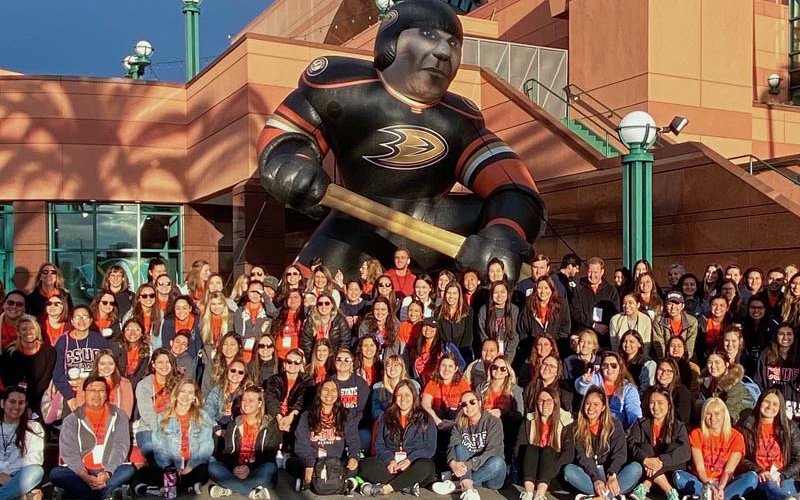
What do hockey and electricity have in common? Score!
When a goal is scored by the Anaheim Ducks, a horn blasts the arena with sound and a red light flashes behind the goal. For Ducks players and fans, this electrifying event is known as “Light the Lamp.”
Cal State Fullerton students preparing for teaching careers and their education faculty adviser Christine A. Mayfield helped develop the lessons for “Light the Lamp,” the Ducks’ S.C.O.R.E. (Scholastic Curriculum of Recreation and Education) event — the First Flight Field Trip.
The March 9 field trip at the Honda Center attracted more than 16,000 students — in third through sixth grades — from nearly 200 elementary schools, and focused on the science behind the goal light and the electricity it takes to light it.
Mayfield, lecturer in elementary and bilingual education, has partnered with the Ducks since 2006 to develop the curriculum for the annual field trip. The day of education offers young students the opportunity to learn and apply their knowledge of science, technology, engineering, art and math, known as STEAM, to the game of hockey.
For Mayfield’s role in the partnership, the Ducks presented her with the Community Champion Award at the March 8 hockey game.
Mayfield also enlists College of Education credential and graduate students, who this year taught at the event and helped write lessons on the exploration of electricity and circuitry. For past field trips, curriculum has focused on such topics as how the puck is engineered for maximum play or how the ice affects players’ speed.
“This partnership gives our teacher candidates exposure to real-world connections between STEAM subjects and the many applications they have,” Mayfield said. “Students are able to explore those connections and expand their content knowledge in ways that will help them in their future classrooms.”
Graduate student Annie Bruner, a student in the combined master’s degree in education and credential program to teach elementary-age students, was among about 130 CSUF teacher credential and graduate students who participated. Bruner and her classmates not only taught lessons, but also created a hands-on activity of making Popsicle stick LED flashlights as a fun way to teach young students about circuits and electricity.
“Students learned firsthand about STEAM as it relates to hockey while they identified and witnessed the ways that every light and sound in the hockey arena is powered by electricity and connected by circuits. By the end of the field trip, students realized how electricity is present in their daily lives,” said Bruner, president of Club TEACH, a student organization.
Bruner, who aspires to teach second grade, wanted to get involved as a way to interact with the students and communities she plans to serve as a future teacher.
“I had the opportunity to spend a day impacting thousands of students of various backgrounds as I challenged them to use their creativity to problem-solve and think critically, while having fun,” she said.
“Participating in this event gave me a platform to inspire young students to explore the world of science, technology, engineering, art and math, and show them how they can use their curiosity, creativity and ingenuity to change the world.”